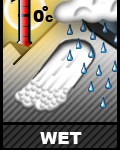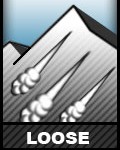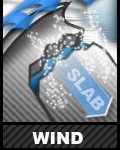Weekend Avalanche Outlook
![]() Avalanche danger will increase through the day, and peak by late afternoon, due to daytime warming and sun exposure. Expect low danger and generally safe conditions in the morning. Dangerous conditions may develop by afternoon with natural and human triggered avalanches (primarily wet) possible, relative to warming and sun exposure. Keep in mind that even if you’re on flat, dry ground; you still may be exposed to large avalanches from snowy slopes above. Avalanche danger will then decrease again overnight and into the next morning, when it will start to increase again with daytime warming and radiation. Expect this melt-freeze cycle to continue for the rest of the season. Eventually, the overnight freeze will stop happening and a “shed” cycle will commence. Keep track of overnight temps: the harder the overnight freeze, the less dangerous conditions will be early the following day. On the other hand, the weaker the overnight freeze, the more dangerous conditions may potentially become the next day.
Avalanche danger will increase through the day, and peak by late afternoon, due to daytime warming and sun exposure. Expect low danger and generally safe conditions in the morning. Dangerous conditions may develop by afternoon with natural and human triggered avalanches (primarily wet) possible, relative to warming and sun exposure. Keep in mind that even if you’re on flat, dry ground; you still may be exposed to large avalanches from snowy slopes above. Avalanche danger will then decrease again overnight and into the next morning, when it will start to increase again with daytime warming and radiation. Expect this melt-freeze cycle to continue for the rest of the season. Eventually, the overnight freeze will stop happening and a “shed” cycle will commence. Keep track of overnight temps: the harder the overnight freeze, the less dangerous conditions will be early the following day. On the other hand, the weaker the overnight freeze, the more dangerous conditions may potentially become the next day.
Avalanche Problems:
 Wet avalanches may possibly be both naturally and human triggered during the afternoon hours this weekend, primarily in the form of wet loose avalanches (aka sluffs, point releases) on steep (35*+) south to west aspects. Wet slabs are lower probability, but higher consequence. Clues to danger will include gloppy, wet, and heavy snow; less supportable snowpack; and naturally occurring small, wet loose avalanches. Consider the overnight freeze, daytime warming, and solar radiation when making an initial danger assessment and planning your day.
Wet avalanches may possibly be both naturally and human triggered during the afternoon hours this weekend, primarily in the form of wet loose avalanches (aka sluffs, point releases) on steep (35*+) south to west aspects. Wet slabs are lower probability, but higher consequence. Clues to danger will include gloppy, wet, and heavy snow; less supportable snowpack; and naturally occurring small, wet loose avalanches. Consider the overnight freeze, daytime warming, and solar radiation when making an initial danger assessment and planning your day.
Small (D1) wind slabs sensitive to human triggers may exist on steep (35*+) terrain in isolated upper elevation areas (3500’+), primarily along leeward ridgelines and cross-loaded features (west to north aspects). Keep terrain traps and exposure in mind.
 Small (D1) loose snow avalanches are possible on steep (35*+), upper elevation northerly aspects. Practice good sluff management.
Small (D1) loose snow avalanches are possible on steep (35*+), upper elevation northerly aspects. Practice good sluff management.
![]() Cornice falls are possible. If you’re in an area with larger cornices, give them a wide berth. Don’t approach the edge of snowy and potentially corniced ridgelines. While a cornice fall is inherently dangerous, it could also trigger a subsequent avalanche.
Cornice falls are possible. If you’re in an area with larger cornices, give them a wide berth. Don’t approach the edge of snowy and potentially corniced ridgelines. While a cornice fall is inherently dangerous, it could also trigger a subsequent avalanche.

